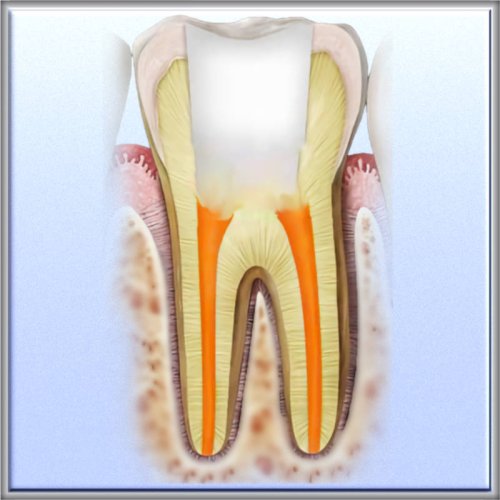
Introduction
Root canal treatment is very popular in conventional dentistry. About 40,000 to 50,000 are performed DAILY in the United States, affecting about 25 to 30 MILLION people annually. Ironically, root canal treatment remains popular despite its painful and notorious reputation. We've all heard the excruciating stories so many times that even the phrase "root canal" invokes fear. In addition, by now, many of us have heard the "conspiracy theories" about how root canals cause cancer, and that there might be a better way.
Given this reputation, many people look to biological dentistry for alternatives or prevention.
What is a Root Canal?
Teeth are held in by their roots and are kept alive by the blood flow inside the root canal.
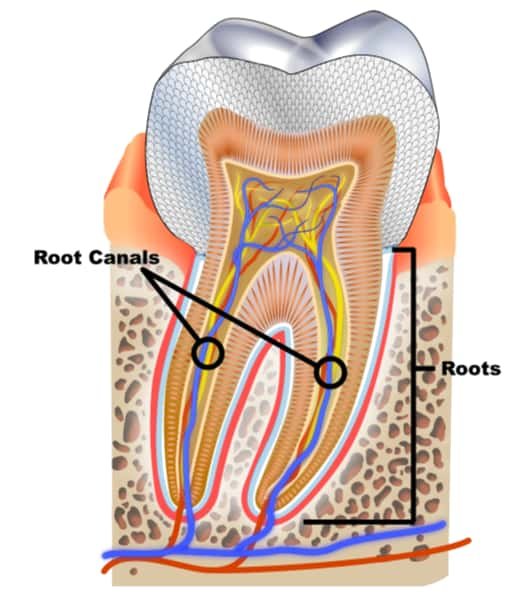
The blood supply, which is a part of the "pulp," keeps the tooth alive so it can feel, cleanse, and rebuild. Sometimes things go wrong, and the pulp, commonly called the "nerve," can become inflamed, get infected, or become painful. The most common reasons are a deep cavity or physical trauma. Throbbing, aching, swelling, and hypersensitivity are the most obvious symptoms that drive someone to the dentist for a solution to the urgent issue. A root canal procedure is a quick and convenient solution that reduces pain, "saves the tooth," and "eliminates infection."
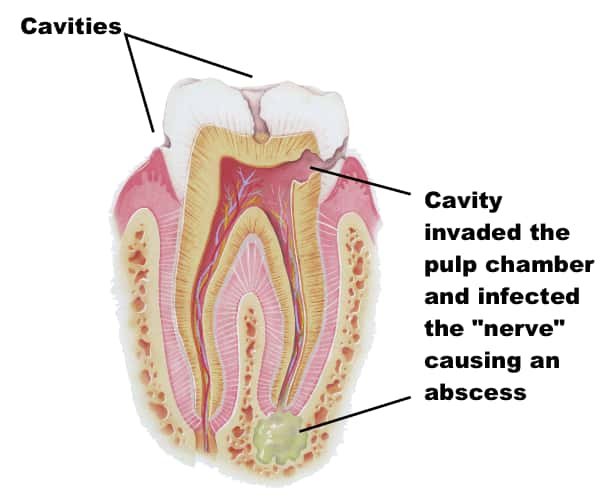
The procedure starts by creating an entrance through the top of the tooth to access the pulp chamber. Then the pulp (blood vessels, nerves, lymph vessels, and other tissue and cells) are cleaned out with small instruments. The hollowed-out space is rinsed and disinfected, then filled and sealed.
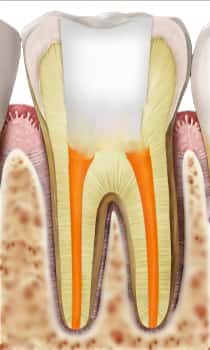
The orange area in the photo is a rubber-based material called "gutta-percha" that is used to fill the root canal space. The idea is that by filling the pulp space and main root canals, bacteria are kept out, pain is gone, and infection is prevented.
What's So Bad About That?
In the past, "rumors" that root canals cause cancer were connected to the use of formaldehyde, a carcinogen found in the sealer. However, a few decades ago, formaldehyde was removed as an ingredient. Yet, you might have still heard more recently that "root canals are toxic" and believed that the sealer or the filler (gutta-percha) were the culprits. I've been asked countless times, "can't root canals be done using non-toxic materials?" Well, biocompatible ceramic sealers are readily available today. But, the problem is NOT about the materials used.
In an attempt to whitewash root canals, some dentists take advantage of the reputation built by holistic and biological dentistry and advertise a "holistic root canal" using modern buzzwords like lasers, PRF, and ozone. A relatively newer technology called GentleWave is known for its unique ability to use pressure with a sequence of irrigating fluids to cleanse deeper and better than traditional methods.
All these methods are great, and have helped a root canal treated tooth stay dormant longer. There's nothing inherently wrong with any of these methods. In fact, if you choose to receive a root canal treatment, GentleWave, lasers, and/or ozone are great tools that help ensure a better result.
The Benefits
By removing the infected and painful nerve tissue, the structure of the tooth remains, allowing it to continue to function to chew and to support the bite, neighboring teeth, and the jaw. It should be clear why this method is appealing, especially since it can solve a painful crisis situation in just an hour or two.
The Truth
A root canal system can be filled with any non-toxic or biocompatible material that exists or will one day be invented. It can be treated with any combination of modern methods that employ high-tech tools. A "successful" outcome means that the tooth is aseptic and the root canals are filled and sealed. The tooth can now function pain-free. All that is great. But it's not the materials or methods that are the problem. There are deeper issues which haven't been and cannot be addressed by even the most modern technology.
In this diagram, you can see the large chamber and canals highlighted by blue embossing. These parts of the tooth can be accessed relatively easily by dentists or endodontists (specialists that perform root canal treatments). They can be cleaned and sealed, keeping bacteria out of those spaces.
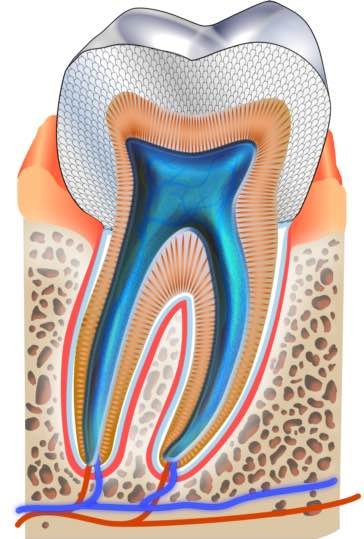
But notice the side tubules, the little tunnels that connect those spaces to the surface. These are dentinal tubules. They're tiny -- about 5 microns in diameter. The dentinal tubule system is so intricate, and they are so numerous, that their cumulative length goes up to several miles in just a single tooth -- about 9 miles in a molar, maybe 3 miles in a smaller tooth.
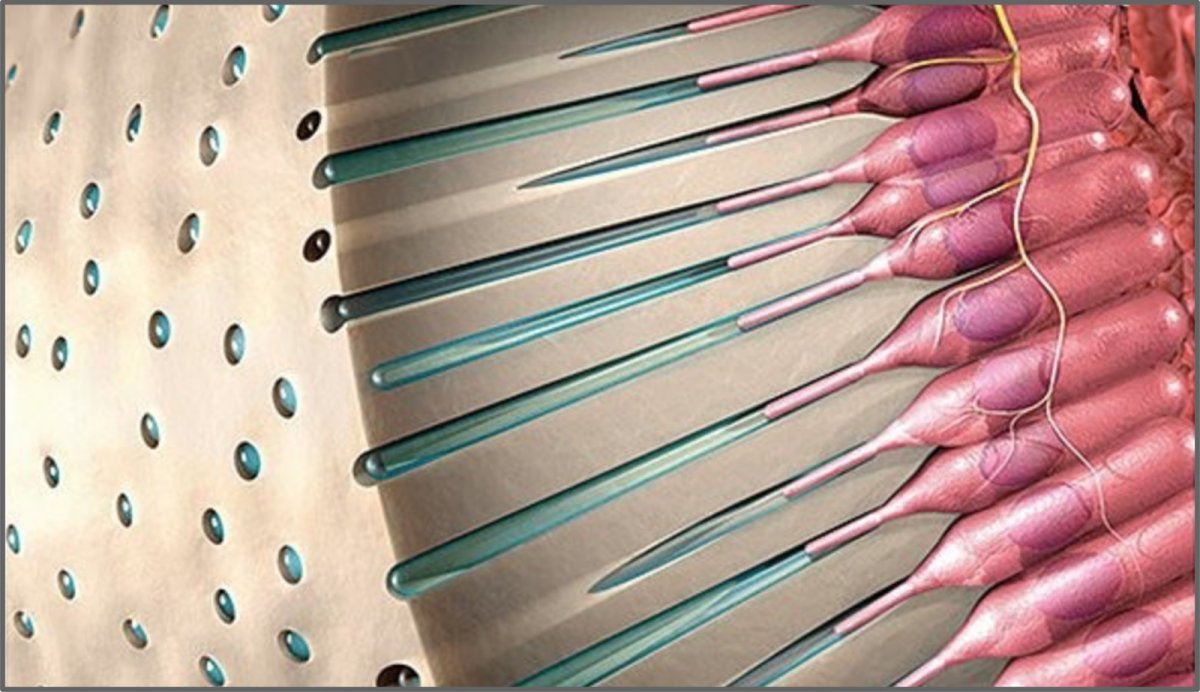
The dentinal tubules of a tooth are inaccessible during a root canal procedure. They can't be thoroughly cleaned, filled, or sealed. All the above technologies have been tested and retested and checked and rechecked under a microscope, and none have ever succeeded in sealing the dentinal tubules end to end. They're just too long and fine. Imagine trying to push jello through a mile long curved coffee straw with just your thumb.
What this means is that the well-done, aseptic root-canal treated tooth is protected from bacteria on a "macroscopic" level (the main canals and chamber) but remains unprotected on a microscopic level (the dentinal tubules).
After the root canal treatment is completed, bacteria are free to enter the tooth thru the dentinal tubules. While the tooth was alive, there was flow, and pressure, keeping bacteria out. But with that natural process now missing, there's nothing to stop bacteria from migrating in. The tubules are full of protein which the bacteria can feed on. The root canal treated tooth has become a dead, porous structure which sits in an environment full of bacteria. Imagine dipping a kitchen sponge into a bowl of bacteria. All you get is a sponge full of bacteria.
The bacteria freely enter the tooth from the external root surfaces, and travel up the tubing. Thus, all root canal treated teeth fill up with miles and miles of bacteria very quickly because there is no defense mechanism to stop them. Neither the immune system nor antibiotics have access to these dentinal tubules of a root canal treated tooth. The colonization starts with the most abundant bacteria in the mouth, aerobic commensal bacteria. Over a very short time (hours) the tubule system is clogged with biofilm and becomes depleted of oxygen. The commensal population begins to shift to anaerobic bacteria. The bacteria becomes more and more toxic very quickly. In fact a study that examined thousands of root canal treated teeth found that 100% of them were filled with anaerobic bacteria with no exceptions.
Anaerobic bacteria migrate out of the tooth into the surrounding tissues and bone. They are made of and leach off endless amount of lipopolysaccharide which drains into the mouth and down the nearby veins and lymph vessels. Lipopolysaccharide (LPS) is extremely toxic, acting as one of the most potent toxins and oxidants known. The effects of all this LPS on the body differ dramatically from person-to-person and tooth-to-tooth.
Other toxins are also released such as mercaptans, thioethers, and more. We believe that these toxins are able to inhibit the proteins that suppress tumor development. This is why cancer is so frequently correlated with root canal treated teeth.
Well known cardiologist Dr. Levy reports that over 95% of heart-attacks are caused by root canal treated teeth. Anecdotally, we see over and over that when cancer occurs, it is usually found along the meridian and lymphatic pathway of a root canal treated tooth.
In addition, performing a root canal treatment can break the meridian system which was communicating through that tooth, disconnecting comm lines from certain parts of the body to other parts. This is esoteric and yet disruptive to healthy function. We often find dysfunction in tissues that fall on the meridian line of a root canal. For example, the upper first molars affect the thyroid, the breasts, and the knee. Shocking statistics also reveal that 98% of breast cancer cases have a root canal in one of the teeth (such as an upper molar) that is linked by meridian to the breast on that side of the body.
If you have a root canal and want to investigate its effects on your body, a thermogram can be a telling way to visualize inflammation. Just look for a thermographer near you and ask for a "head and neck" or "upper body" or even "full body" thermogram. It's non-invasive (just a regular old camera with heat-sensitive film) and quick. Your thermographer will interpret the results and write a report which they will forward to us (or you can send to us). You can also ask us for a referral to a thermography center nearby.
When is a Root Canal OK?
Reading above, one can see that root canal treatment may not be harmonious to long-term health. But in the short term for specific purposes, root canal treatment can be done to facilitate a bigger treatment plan that may involve orthodontics or extractions. A root canal treatment can also help buy time for situations where someone is not physiologically ready for an extraction yet, or might be too young to receive a dental implant.
Root Canal Alternatives?
In biological dentistry, all possible efforts are made to avoid the need for root canal treatment. Starting from early education, nutrition, supplements, diet, hygiene techniques, airway intervention, gut health, thyroid health, acid/alkaline balancing and more, the aim in biological dentistry is to prevent cavities and trauma (clenching / grinding) so the need for a root canal treatment is nearly eliminated.
In the case of a deep cavity or fracture, ozone and biomimetic techniques can help save the pulp of a tooth, keeping it healthy and alive, thus avoiding the need for a root canal. This is called "vital pulp therapy."
If a tooth is already dead, then extraction and replacement with a dental implant might be considered as an alternative to root canal treatment..
More Resources
If root canals are a concern for you, your Biological Consultation will go into more detail so you can make a fully informed decision.
If you'd like to learn more, there are many books on the topic, but my favorite is: Hidden Epidemic by Dr. Tom Levy. This older article from Dr. Mercola is quite informative too.
And don't miss the controversial movie that heated up the industry, The Root Cause.

Categories: Root Canals




